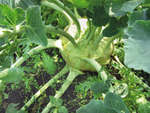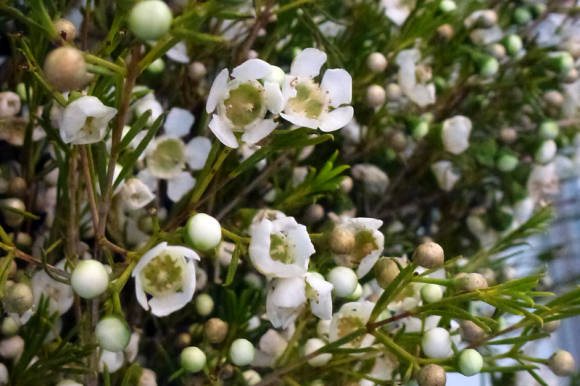 |
Kohlrabi cabbage - in appearance it is a stump that has grown into a round ball, called a stalk-plant, and it tastes like a stump from white cabbage, only much more tender and sweeter. It contains a lot of proteins, vitamins, enzymes, mineral salts, it is especially rich in calcium.
Since this is a very early ripening vegetable (65-75 days from germination to ripeness, it can be harvested earlier), kohlrabi cabbage can be sown throughout May and until mid-June - it will have time to grow until autumn.
Kohlrabi landing
 |
Kohlrabi can be sown with seedlings, which are convenient to grow in a greenhouse. A good seedling age is 35-45 days. You can sow with dry seeds in the ground, but then you need to make sure that the soil under the crops does not dry out until the shoots appear and get stronger. Kohlrabi, sown in April-early May, yields a harvest at the same time as the long-awaited zucchini, cucumbers, tomatoes, early potatoes, that is, when there are a lot of fresh vegetables, and there is simply no turn to it on the table. It is much more interesting to grow kohlrabi for autumn consumption, when everyone is already full of their first favorite vegetables, and then kohlrabi will be very useful. For such a crop, kohlrabi must be sown from June 1 to June 15 for seedlings or directly into open ground.
The recommended distance for planting between kohlrabi cabbage plants is 30-35 cm for early varieties and 40-50 cm for later varieties. For kohlrabi, you can not select a personal garden bed, but plant it as a sealant for late varieties of white cabbage. Kohlrabi will ripen quickly, and the white cabbage will grow further, occupying the space vacated after harvesting the kohlrabi. With late sowing, kohlrabi can be sown on beds with remnants of half-harvested radish or lettuce, watercress, onions per feather, etc. You can sow at different times with an interval of two weeks in groups of several plants. Then it will keep up at different times. After all, fresh, from the garden, is always tastier.
Kohlrabi is not capricious in relation to light, it can be sown with a little shade. It is not as demanding on the soil as other types of cabbage. It can grow on non-nutritive soil. However, the juiciest and sweetest stems are obtained on well-fertilized soils, which also have enough moisture. On acidic and lean soils, the stems are tough, with coarse vascular fibers inside. Such heads are difficult to cut from the garden; you have to use an ax or a saw to separate them from the graceful-looking leg. Therefore, before sowing, it is imperative to fertilize the garden bed with a bucket of compost or humus for each square meter, adding an additional tablespoon of mineral fertilizer such as "Kemira".
Caring for kohlrabi plantings is extremely simple: water if it is very dry, otherwise the pulp will be tough; loosen after watering; remove weeds, collect pests, which, however, do not particularly pamper this cabbage with their attention. And one more plus: unlike other cabbages, kohlrabi does not require hilling.
With late sowing, you can leave kohlrabi plants in the garden until late autumn, because they can withstand fairly strong autumn frosts - up to minus 3-5 degrees and do not woody at the same time. Until late, you can leave the giant varieties in the garden. In general, kohlrabi should be removed from the garden without delay, as soon as it reaches the diameter inherent in this variety, while it has a delicate rind and pulp. Usually its diameter is about 10 cm.
Kohlrabi varieties: "Vienna White", "Delicacy Blue", "Madonna", "Giant".









